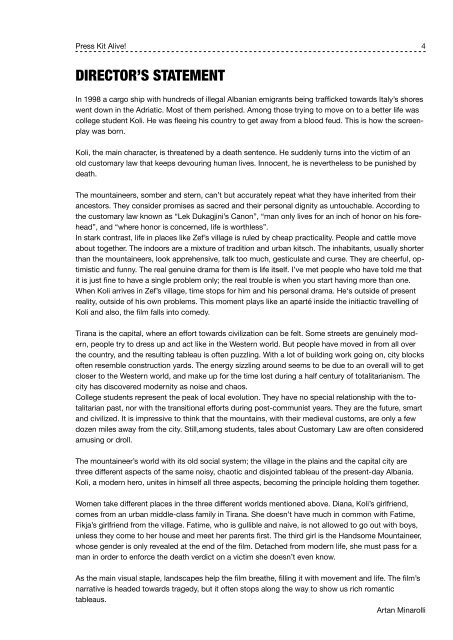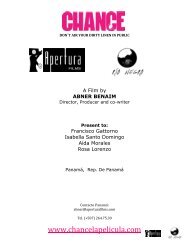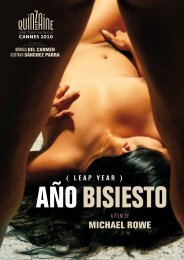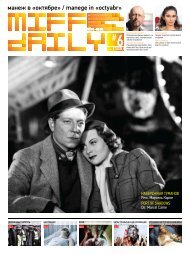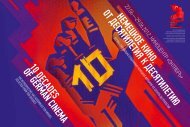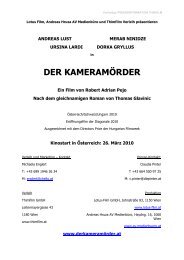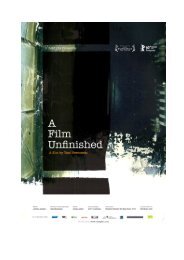PRESS KIT
PRESS KIT
PRESS KIT
You also want an ePaper? Increase the reach of your titles
YUMPU automatically turns print PDFs into web optimized ePapers that Google loves.
Press Kit Alive! 4<br />
DIRECTOR’S STATEMENT<br />
In 1998 a cargo ship with hundreds of illegal Albanian emigrants being trafficked towards Italy’s shores<br />
went down in the Adriatic. Most of them perished. Among those trying to move on to a better life was<br />
college student Koli. He was fleeing his country to get away from a blood feud. This is how the screenplay<br />
was born.<br />
Koli, the main character, is threatened by a death sentence. He suddenly turns into the victim of an<br />
old customary law that keeps devouring human lives. Innocent, he is nevertheless to be punished by<br />
death.<br />
The mountaineers, somber and stern, can’t but accurately repeat what they have inherited from their<br />
ancestors. They consider promises as sacred and their personal dignity as untouchable. According to<br />
the customary law known as “Lek Dukagjini’s Canon”, “man only lives for an inch of honor on his forehead”,<br />
and “where honor is concerned, life is worthless”.<br />
In stark contrast, life in places like Zef’s village is ruled by cheap practicality. People and cattle move<br />
about together. The indoors are a mixture of tradition and urban kitsch. The inhabitants, usually shorter<br />
than the mountaineers, look apprehensive, talk too much, gesticulate and curse. They are cheerful, optimistic<br />
and funny. The real genuine drama for them is life itself. I’ve met people who have told me that<br />
it is just fine to have a single problem only; the real trouble is when you start having more than one.<br />
When Koli arrives in Zef’s village, time stops for him and his personal drama. He‘s outside of present<br />
reality, outside of his own problems. This moment plays like an aparté inside the initiactic travelling of<br />
Koli and also, the film falls into comedy.<br />
Tirana is the capital, where an effort towards civilization can be felt. Some streets are genuinely modern,<br />
people try to dress up and act like in the Western world. But people have moved in from all over<br />
the country, and the resulting tableau is often puzzling. With a lot of building work going on, city blocks<br />
often resemble construction yards. The energy sizzling around seems to be due to an overall will to get<br />
closer to the Western world, and make up for the time lost during a half century of totalitarianism. The<br />
city has discovered modernity as noise and chaos.<br />
College students represent the peak of local evolution. They have no special relationship with the totalitarian<br />
past, nor with the transitional efforts during post-communist years. They are the future, smart<br />
and civilized. It is impressive to think that the mountains, with their medieval customs, are only a few<br />
dozen miles away from the city. Still,among students, tales about Customary Law are often considered<br />
amusing or droll.<br />
The mountaineer’s world with its old social system; the village in the plains and the capital city are<br />
three different aspects of the same noisy, chaotic and disjointed tableau of the present-day Albania.<br />
Koli, a modern hero, unites in himself all three aspects, becoming the principle holding them together.<br />
Women take different places in the three different worlds mentioned above. Diana, Koli’s girlfriend,<br />
comes from an urban middle-class family in Tirana. She doesn’t have much in common with Fatime,<br />
Fikja’s girlfriend from the village. Fatime, who is gullible and naive, is not allowed to go out with boys,<br />
unless they come to her house and meet her parents first. The third girl is the Handsome Mountaineer,<br />
whose gender is only revealed at the end of the film. Detached from modern life, she must pass for a<br />
man in order to enforce the death verdict on a victim she doesn’t even know.<br />
As the main visual staple, landscapes help the film breathe, filling it with movement and life. The film’s<br />
narrative is headed towards tragedy, but it often stops along the way to show us rich romantic<br />
tableaus.<br />
Artan Minarolli


